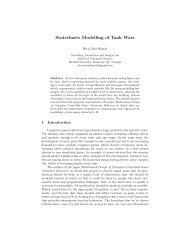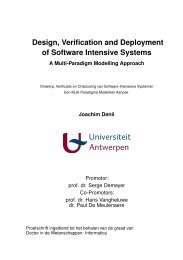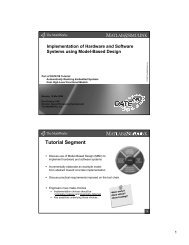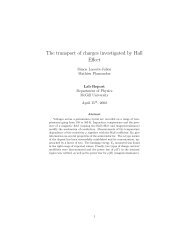Causal Block Diagram algorithms - MSDL
Causal Block Diagram algorithms - MSDL
Causal Block Diagram algorithms - MSDL
You also want an ePaper? Increase the reach of your titles
YUMPU automatically turns print PDFs into web optimized ePapers that Google loves.
<strong>Causal</strong> <strong>Block</strong> <strong>Diagram</strong> <strong>algorithms</strong><br />
Hans Vangheluwe<br />
The following are concise notes on some simple <strong>algorithms</strong> needed to implement a Time Slicing simulator of <strong>Causal</strong><br />
<strong>Block</strong> <strong>Diagram</strong>s. For more details, refer to your own class notes.<br />
<strong>Causal</strong> <strong>Block</strong> <strong>Diagram</strong>s<br />
A <strong>Causal</strong> <strong>Block</strong> <strong>Diagram</strong> model is a graph made up of connected operation blocks. The connections stand for signals.<br />
<strong>Block</strong>s can be purely algebraic such as Adder and Product, or may involve some notion of time such as Delay, Integrator<br />
and Derivative. Furthermore, Input and Output blocks are often used to model the system’s connection to its environment.<br />
Though the actual Time Slicing simulation algorithm needs to know the function of the blocks in the block diagram,<br />
the order in which blocks need to be computed can be determined by abstracting the block diagram to a dependency<br />
graph (describing the dependencies between signals). The actual nature of the dependencies (possibly highly non-linear)<br />
is abstracted away.<br />
The dependencies between signals on either side of a block which denotes some form of time delay (such as Delay,<br />
Integrator or Derivative), do not show up in a dependency graph as these blocks relate signal values at different time<br />
instants.<br />
If the dependency graph does not contain dependency cycles, a simple topological sort will give an order in which the<br />
blocks need to be evaluated to give correct simulation results (i.e., corresponding to the model’s semantics). Note how<br />
there may be many different equivalent (from the point of view of the correctness of the simulation results) topological<br />
sort orderings corresponding to different orders in which neigbours of a node are visited.<br />
Topological Sort<br />
# topSort() and dfsLabelling() both refer<br />
# to global counter dfsCounter which will be<br />
# incremented during the topological sort.<br />
# It will be used to assign an orderNumber to<br />
# each node in the graph.<br />
dfsCounter = 1<br />
# topSort() performs a topological sort on<br />
# a directed, possibly cyclic graph.<br />
def topSort(graph):<br />
# Mark all nodes in the graph as un-visited<br />
for node in graph:<br />
node.visited = FALSE<br />
# Some topSort <strong>algorithms</strong> start from a "root" node<br />
# (defined as a node with in-degree = 0).<br />
1
# As we need to use topSort() on cyclic graphs (in our strongComp<br />
# algorithm), there may not exist such a "root" node.<br />
# We will keep starting a dfsLabelling() from any node in<br />
# the graph until all nodes have been visited.<br />
for node in graph:<br />
if not node.visited:<br />
dfsLabelling(node)<br />
# dfsLabelling() does a depth-first traversal of a possibly<br />
# cyclic directed graph. By marking nodes visited upon first<br />
# encounter, we avoid infinite looping.<br />
def dfsLabelling(node, graph):<br />
# if the node has already been visited, the recursion stops here<br />
if not node.visited:<br />
# avoid infinite loops<br />
node.visited = TRUE<br />
# visit all neigbours first (depth first)<br />
for neigbour in node.out_neigbours:<br />
dfsLabelling(neighbour, graph)<br />
# label the node with the counter and<br />
# subsequently increment it<br />
node.orderNumber = dfsCounter<br />
dfsCounter += 1<br />
Strongly Connected Components<br />
If a CBD model’s dependency graph contains dependency cycles, these need to be identified and replaced by an implicit<br />
solution (analytical or numerical). Note how often, a small Delay (or Integrator) is inserted to “break the loop” and hence<br />
avoid implicit solving. Finding dependency cycles is also known as locating strongly connected components in a graph.<br />
A strongly connected component is a set of nodes in a graph whereby each node is reachable from each other node in the<br />
strongly connected component.<br />
# Produce a list of strong components.<br />
# Strong components are given as lists of nodes.<br />
# If a node is not in a cycle, it will be in a strong<br />
# component with only itself as a member.<br />
def strongComp(graph):<br />
# Do a topological ordering of nodes in the graph<br />
topSort(graph)<br />
# note how the ordering information is not lost<br />
# in subsequent processing and will be used during<br />
# Time Slicing simulation.<br />
2
# Produce a new graph with all edges reversed.<br />
rev_graph = reverse_edges(graph)<br />
# Start with an empty list of strong components<br />
strong_components = []<br />
# Mark all nodes as not visited<br />
# setting the stage for some form of dfs of rev_graph<br />
for node in rev_graph:<br />
node.visited = FALSE<br />
# As strong components are discovered and added to the<br />
# strong_components list, they will be removed from rev_graph.<br />
# The algorithm terminates when rev_graph is reduced to empty.<br />
while rev_graph != empty:<br />
# Start from the highest numbered node in rev_graph<br />
# (the numbering is due to the "forward" topological sort<br />
# on graph<br />
start_node = highest_orderNumber(rev_graph)<br />
# Do a depth first search on rev_graph starting from<br />
# start_node, collecting all nodes visited.<br />
# This collection (a list) will be a strong component.<br />
# The dfsCollect() is very similar to strongComp().<br />
# It also marks nodes as visited to avoid infinite loops.<br />
# Unlike strongComp(), it only collects nodes and does not number<br />
# them.<br />
component = dfsCollect(start_node, rev_graph)<br />
# Add the found strong component to the list of strong components.<br />
strong_components.append(component)<br />
# Remove the identified strong component (which may, in the limit,<br />
# consist of a single node).<br />
rev_graph.remove(component)<br />
Time Slicing<br />
A Time Slicing simulator for <strong>Causal</strong> <strong>Block</strong> <strong>Diagram</strong>s calculates the “behaviour” of a <strong>Causal</strong> <strong>Block</strong> <strong>Diagram</strong> model. In<br />
the case of no-time (data flow) and discrete-time CBDs, the result will be identical to the analytical result. In the case of<br />
continuous-time CBDs, the result approximates the analytical result. The error made in the approximation is determined<br />
by the simulation step-size (slice-size) ∆t (given by the experimentation environment user). The simulator iteratively<br />
updates the variables in the system and advances the simulation time. The simulator has a main loop in which the state of<br />
each block is updated based on the state of its influencers.<br />
Integrator/Delay/Derivative blocks are processed first, then all the Algebraic blocks (in sorted order). Note how there may<br />
be Integrator/Delay/Derivative block cycles. These would not have been detected during the strong component detection<br />
as we had removed all dependencies over Integrator/Delay/Derivative blocks (as they relate variables at different times<br />
and as such can’t lead to zero-time-advance infinite loops). These Integrator/Delay/Derivative block cycles do imply that<br />
3
we need to first store the results of processing these blocks in a temporary area until all have been processed and only<br />
then update their output !<br />
After all blocks have been processed, the time is advanced by the time-increment. In the case of our Time Slicing algorithm<br />
for continuous-time, the time advance comes from the Euler discretization of the integrating blocks. The simulation<br />
loop will stop if some termination condition is reached. For numerical accuracy reasons, it may be necessary to set the<br />
time-advance ∆t to a very small value.<br />
The output (in file or on plot) the user wants may not require this resolution. Thus, the user gives a Communication<br />
Interval (CI). After every CI time-interval, output will be produced and not necessarily at every time slice !<br />
Note that one can speed up the simulation dramatically by not processing blocks which are not needed to compute new<br />
values of state variables (i.e., which are not needed as input to Integrator/Delay/Derivative blocks). These blocks are part<br />
of the output function λ rather than of the transition function δ (see the class on system specification) and need only be<br />
computed at communication intervals.<br />
# Time Slicing simulation of a model<br />
def timeSlicing(model):<br />
# Build a dependency graph for the model.<br />
# In practice, for efficiency reasons, no separate data structure is built.<br />
# Rather, the topSort() and strongComp() methods are<br />
# written such that they work on the original model graph.<br />
# Conceptually however, we reason about a separate dependency graph.<br />
dep_graph = dependency(model)<br />
# Identify strong components<br />
strong_components = strongComp(dep_graph)<br />
# Replace all "real" strong components<br />
for component in strong_components:<br />
if len(component) > 1:<br />
Replace this part of the model by an implicit solution<br />
This implicit solution is either obtained by a<br />
call to a numerical solver or by replacing the strong component<br />
by a new model-segment representing the analytical solution for<br />
that strong component.<br />
Note: we can also inform the user and cowardly give up<br />
(which is what you do in assignment 1).<br />
# After this pre-processing, we’re ready for the actual<br />
# Time Slicing simulation.<br />
# Set the time to the initial time<br />
t = t_initial<br />
# The solution at t = t_initial<br />
Process ALL blocks in topsort order<br />
4
Output (only) desired output variables at this time t<br />
# Advance time to the next slice<br />
t += delta_t (= 1 for discrete-time CBDs)<br />
# The main simulation loop<br />
# Often the termination condition is<br />
# (t > t_final)<br />
while not termination_condition:<br />
Process time-delay blocks in any order<br />
# Caveat: as time-delay blocks may occur in cycles,<br />
# we need to store the results of processing these blocks<br />
# in a temporary area until all have been processed and only<br />
# then update their output !<br />
Process non-delay blocks in topSort order<br />
Output (only) desired output variables at time t<br />
# Advance the time<br />
t += delta_t (= 1 for discrete-time CBDs)<br />
5
















